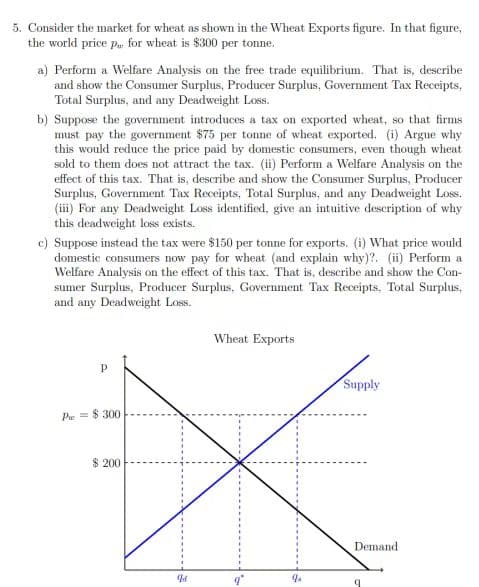Consider the market for wheat as shown in the Wheat Exports figure. In that figure, the world price p. for wheat is $300 per tonne. a) Perform a Welfare Analysis on the free trade equilibrium. That is, describe and show the Consumer Surplus, Producer Surplus, Government Tax Receipts, Total Surplus, and any Deadweight Loss. b) Suppose the government introduces a tax on exported wheat, so that firms must pay the government $75 per tonne of wheat exported. (i) Argue why this would reduce the price paid by domestic consumers, even though wheat sold to them does not attract the tax. (ii) Perform a Welfare Analysis on the effect of this tax. That is, describe and show the Consumer Surplus, Producer Surplus, Government Tax Receipts, Total Surplus, and any Deadweight Loss. (iii) For any Deadweight Loss identified, give an intuitive description of why this deadweight loss exists. c) Suppose instead the tax were $150 per tonne for exports. (i) What price would domestic consumers now pay for wheat (and explain why)?. (ii) Perform a Welfare Analysis on the effect of this tax. That is, describe and show the Con- sumer Surplus, Producer Surplus, Government Tax Receipts, Total Surplus. and any Deadweight Loss.
Consider the market for wheat as shown in the Wheat Exports figure. In that figure, the world price p. for wheat is $300 per tonne. a) Perform a Welfare Analysis on the free trade equilibrium. That is, describe and show the Consumer Surplus, Producer Surplus, Government Tax Receipts, Total Surplus, and any Deadweight Loss. b) Suppose the government introduces a tax on exported wheat, so that firms must pay the government $75 per tonne of wheat exported. (i) Argue why this would reduce the price paid by domestic consumers, even though wheat sold to them does not attract the tax. (ii) Perform a Welfare Analysis on the effect of this tax. That is, describe and show the Consumer Surplus, Producer Surplus, Government Tax Receipts, Total Surplus, and any Deadweight Loss. (iii) For any Deadweight Loss identified, give an intuitive description of why this deadweight loss exists. c) Suppose instead the tax were $150 per tonne for exports. (i) What price would domestic consumers now pay for wheat (and explain why)?. (ii) Perform a Welfare Analysis on the effect of this tax. That is, describe and show the Con- sumer Surplus, Producer Surplus, Government Tax Receipts, Total Surplus. and any Deadweight Loss.
Principles of Macroeconomics (MindTap Course List)
8th Edition
ISBN:9781305971509
Author:N. Gregory Mankiw
Publisher:N. Gregory Mankiw
Chapter9: Application: International Trade
Section: Chapter Questions
Problem 10PA
Related questions
Question

Transcribed Image Text:5. Consider the market for wheat as shown in the Wheat Exports figure. In that figure,
the world price p. for wheat is $300 per tonne.
a) Perform a Welfare Analysis on the free trade equilibrium. That is, describe
and show the Consumer Surplus, Producer Surplus, Government Tax Receipts,
Total Surplus, and any Deadweight Loss.
b) Suppose the government introduces a tax on exported wheat, so that firms
must pay the government $75 per tonne of wheat exported. (i) Argue why
this would reduce the price paid by domestic consumers, even though wheat
sold to them does not attract the tax. (ii) Perform a Welfare Analysis on the
effect of this tax. That is, describe and show the Consumer Surplus, Producer
Surplus, Government Tax Receipts, Total Surplus, and any Deadweight Loss.
(iii) For any Deadweight Loss identified, give an intuitive description of why
this deadweight loss exists.
c) Suppose instead the tax were $150 per tonne for exports. (i) What price would
domestic consumers now pay for wheat (and explain why)?. (ii) Perform a
Welfare Analysis on the effect of this tax. That is, describe and show the Con-
sumer Surplus, Producer Surplus, Government Tax Receipts, Total Surplus.
and any Deadweight Loss.
P
Pe $300
$ 200
4d
Wheat Exports
qs
Supply
Demand
q
Expert Solution
This question has been solved!
Explore an expertly crafted, step-by-step solution for a thorough understanding of key concepts.
Step by step
Solved in 5 steps with 3 images

Knowledge Booster
Learn more about
Need a deep-dive on the concept behind this application? Look no further. Learn more about this topic, economics and related others by exploring similar questions and additional content below.Recommended textbooks for you

Principles of Macroeconomics (MindTap Course List)
Economics
ISBN:
9781305971509
Author:
N. Gregory Mankiw
Publisher:
Cengage Learning

Principles of Economics, 7th Edition (MindTap Cou…
Economics
ISBN:
9781285165875
Author:
N. Gregory Mankiw
Publisher:
Cengage Learning

Principles of Economics (MindTap Course List)
Economics
ISBN:
9781305585126
Author:
N. Gregory Mankiw
Publisher:
Cengage Learning

Principles of Macroeconomics (MindTap Course List)
Economics
ISBN:
9781305971509
Author:
N. Gregory Mankiw
Publisher:
Cengage Learning

Principles of Economics, 7th Edition (MindTap Cou…
Economics
ISBN:
9781285165875
Author:
N. Gregory Mankiw
Publisher:
Cengage Learning

Principles of Economics (MindTap Course List)
Economics
ISBN:
9781305585126
Author:
N. Gregory Mankiw
Publisher:
Cengage Learning

Principles of Macroeconomics (MindTap Course List)
Economics
ISBN:
9781285165912
Author:
N. Gregory Mankiw
Publisher:
Cengage Learning

Essentials of Economics (MindTap Course List)
Economics
ISBN:
9781337091992
Author:
N. Gregory Mankiw
Publisher:
Cengage Learning

Principles of Microeconomics
Economics
ISBN:
9781305156050
Author:
N. Gregory Mankiw
Publisher:
Cengage Learning